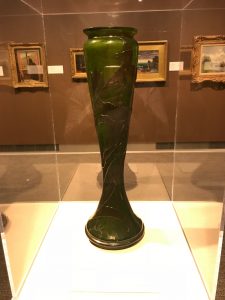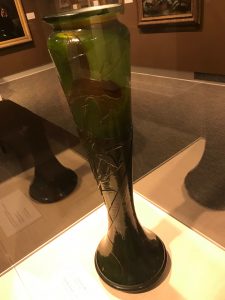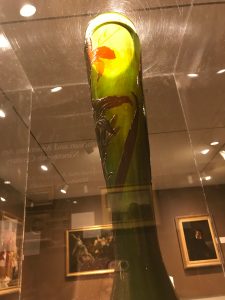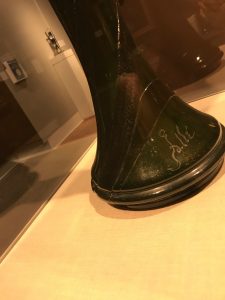The Daylily Vase was created by Emile Gallé in the 1900s. Had professor Cao not given us a list of public pieces, I would not have known this piece was glass. It is so dark in color that I thought it was clay or earthenware. This piece is pretty tall and is a dark green color. The darkest point is the bottom of the vase. The green gets lighter and slightly more translucent moving up the vase around the neck of it. In certain light, it is very visible and clear that it is lighter at that point. You can’t see entirely through it, but the piece does catch some more light in that certain area. It looks textured- having crackled like lines that are darker and also seems to have fleck spots of a lighter brown or gold color. There are dark brown flowers on this piece. They seem to be lilies which makes sense to the name of the piece. They look like they can be peeled off or were added on later to the vase- they look separate but aren’t. At the bottom of the vase appears to be writing of some sort. I can’t tell what it says, but I think it is Emile’s last name.
 This piece, just by looking at it, I would assume was only for decoration. I did try and take a picture of the inside of it and it’s capable of holding something if need be. However, it is taller than a normal flower vase or something similar so if someone did put flowers in it, it would look weird. Gallé worked a lot with nature and flower motifs and was the first to create an “art vase” strictly just for the sake of art. Considering he wanted his work to be expressive and telling objects, I think that supports my thought of this piece not being used functionally but rather just expressively and decoratively.
This piece, just by looking at it, I would assume was only for decoration. I did try and take a picture of the inside of it and it’s capable of holding something if need be. However, it is taller than a normal flower vase or something similar so if someone did put flowers in it, it would look weird. Gallé worked a lot with nature and flower motifs and was the first to create an “art vase” strictly just for the sake of art. Considering he wanted his work to be expressive and telling objects, I think that supports my thought of this piece not being used functionally but rather just expressively and decoratively.
This piece is cameo glass which means it involves creating an image in relief against a contrasting background that consist of many layers of different colored glass. That explains why the piece catches some light in some parts. If it was fully opaque, it would not be able to catch the little light it does. It also explains how this piece was created. It is so tall that I wasn’t sure how it could’ve been made as I don’t think you can pull a piece that long or thick. It was wheel-cut though so that makes more sense with the density and length of the piece as it seems heavier than chemistry glassware would be. Also, the etching and carving that is used to create designs on this type of glass makes sense as to how the lilies were made. I now know that they look like they could be peeled off or added later because they are a relief on the vase.

I really love this vase. The darker color to it makes it more interesting and unique. The lilies on it make me feel calm and give the piece some gentleness to it. I feel that the flowers play to the fragility of glass but I think this glass is so brittle looking and in use that the flowers in this case don’t play to the fragility but rather give it gentleness and delicacy that we normally associate with glass. Other pieces of Gallé’s work are gorgeous as well.
http://www.galleartglass.com/emile-galle-history/
Ackland Object Guide